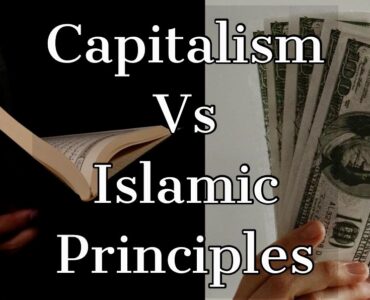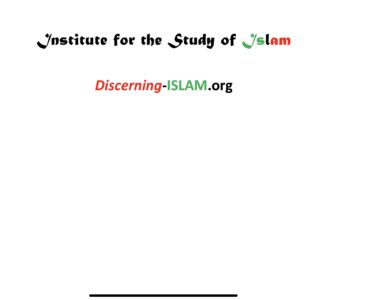
Medieval Muslim Views of Europe, Christians, And Christianity
The vast majority of Muslims in the eastern part of the empire had little if any knowledge of the western regions of Christendom, as well as little interest in discovering anything about lands they considered bleak and remote, inhabited by peoples they thought to be little more than barbarians. They considered the Europeans’ manners and habits to be loathsome, their level of culture exceedingly low, and their religion superseded by Islam. The fact that Europeans spoke many different languages was regarded as a serious liability, allowing none to understand the other. The earliest available records of any Muslim notation of western Europe were in the ninth century, taken primarily from Greek sources. A century later the great Muslim geographer al-Masudi reported in his Fields of Gold on the peoples of the north, listing sixteen Frankish kings, of whom at least ten are authentic. In his Book of Instruction he talked about the translation of the Septuagint, the ecumenical councils of the church, Christian sects and heresies, and a number of details of Christian theology. Al-Masudi was one of the few Muslims who had any interest in the west, however, and it was really the only time that a medieval Muslim historian dealt with any kind of history of the lands of Christendom. To the extent that Muslims knew anything of the papal city of Rome at all, it was often confused with Byzantium, because both were referred to as Rum. A few venturesome easterner travelers managed to visit the city, which served as the center of Roman Christianity, but their records are meager. Most Muslims preferred to go east, to areas that they considered more civilized, than to venture into the cold and inhospitable areas of Europe. In the middle of the tenth century Ibrahim ibn Yaqub al-Israili provided an interesting and at that point unprecedented account of France, Germany, and the lands of the Slavs, one of the few personal descriptions given by a named Muslim visitor to Europe until reports of the Ottoman embassy centuries later.
Even by the twelfth to the fourteenth centuries Muslims had little interest in, and thus generally little knowledge of, the west. What few reports are available come from geographers from the far western reaches of the Islamic empire, namely Andalusia or North Africa. The eleventh century saw the production of the Book of the Categories of Nations by the Andalusian Qadi Said ibn Ahmad, in which he discusses the Greeks, Romans, Franks, and a number of groups from eastern Europe, categorizing Frankish Europeans along with Negro Africans as white and black barbarians of the regions beyond the civilized world. In 1154 a geography by the Arab geographer and cartographer al-Idirisi, written in Sicily, gave some descriptions of Italy and other parts of western Europe, which was the basis for much of what Muslims knew about the Franks. Muslim chronicles from this period treat the activities of the Christian Crusaders in some detail, but they contain little information on what motivated the invading armies or what the differences were in their national constituencies. With very little exception, Muslims were quite unaware of, and clearly disinterested in, the possibility of any kind of cultural developments in the west in the areas of religion, philosophy, science, or the arts. Even the great historian and philosopher Ibn Khaldun did not give much attention to areas north of Spain except to note that some Slavs, other Europeans, and Turkish nations adopted Christianity; the qualities of those living to the north, he noted, are akin to what one finds in animals living in savage isolation who have no community and even eat each other. In discussing Christianity itself, Ibn Khaldun displayed his knowledge of the Bible and church organization. Virtually no works in Latin or any other western language were translated into Arabic.
By the fourteenth century, when the conversion of many of the Mongol tribes was greatly changing the face of eastern Islam, the Persian physician and scholar Rashid al-Din (1247–1318) wrote his history of the Franks (1305–06), part of the second volume of a larger world history. This work deals with ancient Rome and its monuments, miracles of the saints, and some pagan traditions. It contains information about the birth and youth of Jesus, the conversion of the emperor Constantine, some of the better-known popes, and a good deal of legendary material concerning Christians in the Middle Ages. It was through Rashid al-Din’s history that the eastern Islamic world learned for the first time much of this Christian history and lore. On the whole, it was viewed as somewhat of a curiosity, however, without significant importance or influence.
This general lack of interest on the part of medieval Muslims in the lands of western Christianity did not mean, however, that the Christian religion itself was not a matter of concern for many Islamic theologians and scholars. Along with the development of the schools of law and exegesis of the Qur’an there developed a body of literature dealing with Christian doctrine for reasons of polemic and refutation. As was true with Christian polemic against Islam, Muslims sought to support their refutation by looking to their own scripture. For both sides of the argument such retreat into internal resources was doomed to failure. Christians could not be persuaded by the Qur’an, a scripture that they believed to be false, as Muslims could not be persuaded by the Gospel, a scripture they believed to be distorted from its original form.
The Bible itself, in the form held sacrosanct by Christians, received little attention from Muslim polemicists. A few used portions of the Biblical text to buttress their arguments, relying on traditional Muslim exegetical style to do so. Their primary interest in the Bible was as a proof-text for predicting the coming of the Prophet Muhammad, finding occasional references through the text that could be employed for that purpose. In rare instances portions of the Gospel were translated into Arabic and modified to make the text more congenial to the tenets Islam. This was justified by the Muslim conviction that the Christian scripture had been changed and distorted and was thus fair game for revision to bring it closer to the original revelation. After Islam had spread to Syria and Mesopotamia, Persia, North Africa, and Spain, the polemical debate between Muslims and Christians was sparked by the different forms of contact between members of the two faiths. The Arabic language was adopted by growing numbers of Christian dhimmis, especially those living in urban centers, allowing people to read the Qur’an for themselves and providing for the translation of the Bible into Arabic. Even when both sides were able to quote not only their own scripture but that of the other, however, it was still difficult to move beyond attacking the texts held sacred by their opponents on the basis of their own texts.
As early as the ninth century there were a number of Muslim efforts at refutation of the doctrines of Christianity, particularly as they were known through Christians living in Arab lands. Ali al-Tabari (d. 855), a Nestorian Christian who converted late in life to Islam, wrote a rebuttal of Christianity that sounds like a version of Nestorian polemics against other Christian sects. In the 860s Abu Isa al-Warraq provided the most comprehensive of the early anti-Christian polemical works, entitled Reply to the Three Sects of the Christians. Aimed especially at the Nestorians, Jacobites, and Melchites, it deals particularly with the “inconsistencies” of the doctrines of the Trinity and the incarnation. Shortly after that Amr ibn Bahr al-Jahiz wrote a refutation of the Christians for the caliph al-Mutawakkil, who was waging an offensive against the Christians. It is an especially biting attack on the Trinity and on Christianity as a false religion, which, said al-Jahiz, is a sore and a social evil in the midst of the body politic.
When the Abbasid caliph al-Mamun (r. 813–33) established the institute of philosophy or “House of Wisdom” in Baghdad in 830, Greek and Syriac texts on a range of issues, from philosophy to medicine to astrology and mathematics, were translated into Arabic. Muslim scholars soon became as well versed in these materials as their Christian counterparts, often more so, changing the playing field from scriptural argumentation to the more commonly agreed-on basis of the authority of Aristotelian logic and philosophy. In some cases, such as that of the ninth-century Arab philosopher Abu Yusuf Yuqub al-Kindi (795–866) in his Refutation of the Christians, Aristotelian logic was used to combat the Christian idea of the Trinity. (It is an interesting illustration of the way in which refutation was used to promote one’s own interpretation that al-Kindi’s work, not itself extant, is known through the countering arguments of the Jacobite Christian scholar Yahya ibn Adi, who refuted these Muslim arguments in making his own case for the Trinity.) The numbers of scholars on either side who were able to engage in this kind of intellectual debate were limited, however, which is why both Muslims and Christians for the most part carried out their polemic from within their own theological and scriptural frames of reference. In Islam most jurists and theologians were suspicious of such philosophical methodology as somehow running counter to the explicit revelations contained in the Qur’an. Most of the surviving Islamic writing that has made up the body of anti-Christian polemics, then, is Qur’anically based apologetic not intended to debate any issues but simply to affirm what Muslims already believed to be true.
Some Muslim speculative theologians made use of forms of Aristotelian logic in shaping their doctrinal arguments, however, still keeping within the bounds of what was acceptable to the main schools of Islamic theology. They used these arguments to the extent to which they were engaged in combating the ideas of Christian writers, especially regarding the doctrine of the incarnation. The Maliki jurist Abu Bakr al-Baqillani (d. 1013), for example, writing in Baghdad in the eleventh century, is said to have effectively silenced the arguments of Christians by means of sophisticated philosophical arguments, especially in relation to claims of Jesus’ divinity. Such a conclusion, of course, was made by his fellow Muslims, and for either side of the debate the result was predetermined by their unshakable faith in the truth of their own dogmas. The eleventh century also gave birth to the work of the Andalusian philosopher-theologian Ibn Hazm (994–1064), who attacked the Christian scriptures harshly on the basis of a very thorough knowledge of the Bible. His well-known and erudite Book of Sects, purported to be the first Muslim work on comparative religion, is really a defense of Islam against the error of other faiths, particularly Christianity.
The most famous of the late Middle Ages critics of Christianity was the fourteenth-century Hanbali jurist, theologian, and religious reformer Taqi al-Din ibn Taymiyah (1263–1329). He was an independent thinker who was well grounded in a wide range of religious and nonreligious sciences. His enormous work, more than one thousand pages long, entitled The Correct Answer to Those Who Have Changed the Religion of Christ, is a refutation in particular of the work of a Transjordanian Melchite bishop named Peter who wrote at the end of the ninth century. Ibn Taymiyah argued against the possibility of the incarnation of God in Christ, which he refuted by using Peter’s own arguments against him. A deeply scholarly and incisive work, The Correct Answer provides a good example of the way in which challenges between Christianity and Islam were much more often made by the process of textual refutation than through actual face-to-face exchange.
Medieval Muslim Views of Europe, Christians, And Christianity^
803 – 019
Home
Last Updated: 04/2022
See COPYRIGHT information below.



